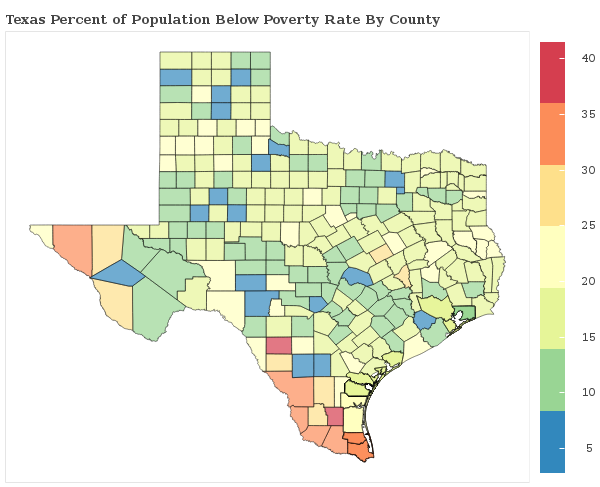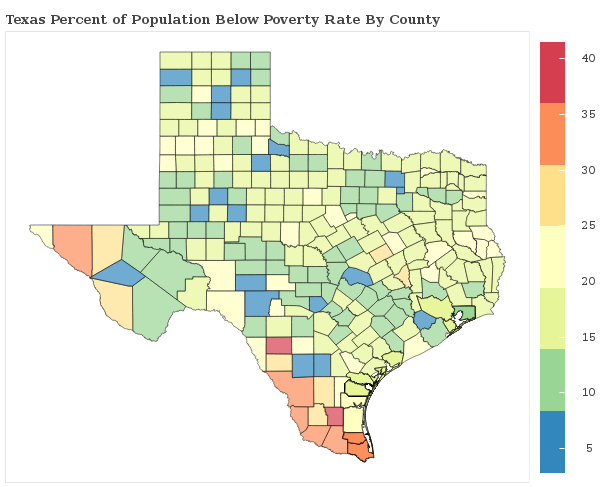Texas has long enjoyed a reputation for its economic might and business-friendly environment. However, behind this façade lies a troubling reality – the deep-seated issue of poverty. While the Lone Star State’s vast landscapes and vibrant cities paint a picture of prosperity, statistics reveal a different story. This article seeks to uncover the truth about Texas’ poverty rankings, examining the factors that contribute to this disheartening trend and exploring possible solutions to alleviate the burden on its residents. Prepare to delve into the often-unseen underbelly of the Texan economy, where the fight against poverty rages on.

This image is property of static.texastribune.org.
1. Overview of Poverty in Texas
1.1 Definition and Measures of Poverty
Poverty, as defined by the U.S. Census Bureau, is a state of lacking sufficient income or resources to meet basic needs. A commonly used measure to determine poverty is the federal poverty line (FPL), which varies based on household size and composition. For example, in 2021, the FPL for a family of four was set at an annual income of $26,500.
1.2 Poverty Rates in Texas
Texas, with its diverse population and large economy, faces significant challenges when it comes to poverty. According to the latest available data from the U.S. Census Bureau, the poverty rate in Texas was 13.7% in 2019, slightly higher than the national average of 10.5%. This translates to approximately 3.5 million Texans living below the poverty line. It is important to note that these figures do not account for the potential impact of the COVID-19 pandemic, which has likely exacerbated poverty rates in recent years.
1.3 Factors Contributing to Poverty
Several factors contribute to the high poverty rates in Texas. One significant factor is the prevalence of low-wage jobs, especially in sectors such as agriculture, construction, and hospitality. Limited access to quality education and healthcare, as well as systemic inequalities, also play a role. Additionally, Texas has a large immigrant population, and immigrants often face unique challenges when it comes to poverty due to language barriers, immigration status, and limited access to social safety net programs.
2. Historical Trends of Poverty in Texas
2.1 Poverty Rates Over Time
Over the past few decades, poverty rates in Texas have fluctuated, influenced by various economic factors and policy changes. In the early 1990s, Texas experienced a peak in poverty rates, with nearly one in four residents living below the poverty line. Since then, there has been a gradual decline in poverty rates, although the progress has been slow. It is worth noting that the recent economic downturn caused by the COVID-19 pandemic may have reversed some of the improvement seen in recent years.
2.2 Impact of Economic Cycles on Poverty
Economic cycles, such as recessions and periods of economic growth, have a direct impact on poverty rates. During economic downturns, poverty rates tend to increase as job losses and reduced economic opportunities make it difficult for individuals and families to make ends meet. Conversely, during periods of economic growth, poverty rates tend to decline as job opportunities expand and incomes rise. However, it is essential to recognize that economic growth alone may not be sufficient to eradicate poverty, as systemic issues and inequalities often persist.
3. Comparison with Other States
3.1 Poverty Rankings among U.S. States
When comparing poverty rates among U.S. states, Texas consistently ranks among the states with higher poverty rates. In 2019, Texas had the 38th highest poverty rate out of 50 states. This highlights the substantial challenges Texas faces in addressing poverty effectively. It is crucial to examine the factors that contribute to this ranking and learn from states with lower poverty rates to develop targeted strategies for poverty reduction.
3.2 Factors Influencing State Rankings
Several factors influence a state’s ranking in terms of poverty rates. These include the overall economic condition, access to education and healthcare, the effectiveness of social safety net programs, and policies aimed at reducing income inequality. States that invest in education, job training, and supportive social programs tend to have lower poverty rates. Additionally, states with stronger social safety nets often see better outcomes in poverty reduction. Understanding these factors is essential in developing effective strategies to improve Texas’ ranking and alleviate poverty.
4. Impact of Poverty on Education
4.1 Educational Challenges Faced by Low-Income Students
Poverty has a profound impact on educational opportunities for low-income students in Texas. Students from low-income families often face various challenges that can hinder their academic success. These challenges include limited access to high-quality early childhood education, inadequate school resources, and lack of necessary support services. Additionally, low-income students are more likely to experience food insecurity, unstable housing situations, and exposure to stressful environments – all of which can negatively affect their academic performance and overall well-being.
4.2 Resource Disparities in Schools
Schools in low-income areas often face resource disparities compared to schools in wealthier communities. This creates an educational disadvantage for low-income students in terms of access to qualified teachers, technology, extracurricular activities, and educational resources. These resource disparities further perpetuate the achievement gap, making it more challenging for low-income students to succeed academically. Closing the resource gap between schools in different socioeconomic areas is crucial to ensure equal educational opportunities for all students, regardless of their background.

This image is property of www.welfareinfo.org.
5. Poverty’s Effect on Healthcare in Texas
5.1 Lack of Access to Affordable Healthcare
Poverty in Texas has significant implications for healthcare access and affordability. Many low-income individuals and families struggle to afford health insurance coverage, making access to essential healthcare services a challenge. The state’s decision not to expand Medicaid under the Affordable Care Act has further limited the availability of affordable healthcare options for low-income Texans. As a result, many individuals delay seeking medical care, leading to increased health complications and preventable illnesses.
5.2 Health Disparities among Low-Income Individuals
Low-income individuals in Texas often face health disparities compared to their higher-income counterparts. Limited access to healthcare providers, lack of preventive care, and higher rates of chronic conditions contribute to poorer health outcomes among low-income populations. These health disparities are further exacerbated by other social determinants of health, such as limited access to nutritious food, safe housing, and quality education. Addressing these disparities and improving healthcare access for low-income individuals is crucial to ensure equitable health outcomes for all Texans.
6. Link between Poverty and Crime
6.1 Poverty’s Influence on Criminal Activities
Poverty has long been associated with higher rates of crime, including property crimes, violent offenses, and drug-related activities. The link between poverty and crime is complex and multifaceted. Poverty can lead to a lack of economic opportunities, limited access to education, and higher levels of stress and despair, all of which can contribute to criminal behavior. Furthermore, individuals living in poverty may resort to illegal activities as a means of survival or as a result of limited choices. Understanding the underlying causes of crime related to poverty is crucial in developing effective crime prevention strategies.
6.2 Addressing Root Causes of Crime
To address the link between poverty and crime effectively, it is essential to focus on addressing the root causes of criminal behavior. This includes implementing comprehensive anti-poverty initiatives that provide economic opportunities, access to quality education, and support services for individuals and families living in poverty. Investing in community development programs, job training, and mental health and substance abuse services can help break the cycle of poverty and reduce the prevalence of crime in Texas communities.

This image is property of upload.wikimedia.org.
7. Government Initiatives to Alleviate Poverty
7.1 Federal Programs Targeting Poverty
The federal government plays a significant role in addressing poverty through various programs and initiatives. Programs such as the Supplemental Nutrition Assistance Program (SNAP), Temporary Assistance for Needy Families (TANF), and the Earned Income Tax Credit (EITC) provide critical support to low-income individuals and families. Medicaid and the Children’s Health Insurance Program (CHIP) also play a vital role in ensuring access to healthcare for low-income populations. Collaboration between federal agencies, state governments, and community organizations is essential to effectively implement and coordinate these initiatives.
7.2 State-Level Anti-Poverty Initiatives
At the state level, Texas has implemented several initiatives to address poverty and its consequences. These include efforts to increase access to affordable housing, job training programs, and support for small businesses. Additionally, the Texas Workforce Commission provides resources and assistance to individuals seeking employment and aims to match job seekers with available opportunities. Texas can further invest in education, expand healthcare access, and create targeted programs that address the specific needs of its diverse population to make substantial progress in reducing poverty statewide.
8. Non-Profit Organizations and Community Efforts
8.1 Role of Non-Profit Organizations in Combatting Poverty
Non-profit organizations play a crucial role in addressing poverty in Texas. These organizations often fill the gaps left by government programs and provide essential services to individuals and communities in need. Non-profits may focus on various aspects of poverty reduction, including providing food assistance, offering job training and education programs, and supporting affordable housing initiatives. Collaborating with non-profit organizations enables communities to leverage their expertise, resources, and community connections to effectively combat poverty at the grassroots level.
8.2 Local Community Initiatives
In addition to non-profit organizations, local communities in Texas have implemented various initiatives to address poverty. These initiatives may include community-led affordable housing projects, mentorship programs for low-income students, and job placement services. Communities can also leverage local resources and partnerships to create comprehensive approaches to poverty reduction, including addressing social determinants of health, promoting financial literacy, and supporting entrepreneurship. By empowering local communities and fostering collaboration, Texas can harness the collective effort needed to make a lasting impact on poverty rates.

This image is property of datawrapper.dwcdn.net.
9. Future Prospects and Challenges
9.1 Potential Strategies for Reducing Poverty Rates
To reduce poverty rates in Texas, a multi-faceted approach is necessary. Investing in education and workforce development programs that provide individuals with the skills needed for high-demand jobs can help increase their economic opportunities. Expanding access to affordable healthcare and promoting preventive care can improve health outcomes and reduce the financial burden on low-income individuals. Strengthening social safety net programs, implementing living wage policies, and advocating for equitable tax policies are also essential strategies to alleviate poverty in Texas.
9.2 Addressing Systemic Inequalities
Addressing systemic inequalities is crucial for long-term poverty reduction. This involves eliminating barriers to education, healthcare, and economic opportunities faced by marginalized communities. Policymakers must prioritize equity in resource allocation, including school funding formulas, healthcare infrastructure, and job creation. Additionally, addressing issues such as racial inequality, gender inequality, and discrimination is paramount to ensure that all individuals and communities have an equal chance to thrive. By addressing systemic inequalities, Texas can create a more just and prosperous future for all its residents.
10. Conclusion
Poverty remains a pressing issue in Texas, with significant implications for individuals, communities, and the overall well-being of the state. Understanding the definition and measures of poverty, historical trends, and the impact on education, healthcare, and crime is crucial in developing comprehensive strategies to address this complex issue. The collaboration between government agencies, non-profit organizations, and local communities is vital in implementing initiatives that target the root causes of poverty and ensure equitable opportunities for all Texans. By investing in education, healthcare, economic opportunities, and addressing systemic inequalities, Texas can make significant progress in alleviating poverty and creating a brighter future for its residents.

This image is property of nowcastsa.com.
